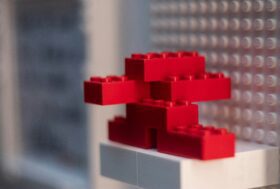Experts in a bottle? 100 years of the teaching machine

When he wasn’t lecturing in psychology at Ohio State University, Sidney Pressey spent his down time building a machine that may one day replace him: a teaching machine.
It was 1921 and the dawns of binary computing, early artificial intelligence and electronic displays had not yet broken. But Pressey’s machine was visionary and could mechanically present questions to students and capture their responses. It offered up a decisive ‘right’ or ‘wrong’. But a teacherly nod, smile or follow-up question were beyond its powers. Soon after, Pressey added two further mechanisms: one that kept students on the same question until they found the correct answer and one that dispensed a sweet when they hit a winning streak.
Almost 100 years and 10 breakthrough decades later, we will look at how those early efforts materialised into today’s $9 billion edtech industry. But we will also ponder why the robot is still not the dominant figure in a child’s education, and why the challenges of Pressey’s day still niggle at futurists now. And finally, we ask what might come next for us as teachers? For clues, we will take a look over the fence at a small but growing number of professions that are already leaning on a digital counterpart.
But first, back to Pressey. By 1936, his idea had caught the imagination of fellow psychologists, and there were nearly 700 patents for similar machines. The arrangements of cam wheels, levers and pulleys varied, but broadly the capabilities were the same. And so were the limitations. The most fundamental of these was their ‘one size fits all’ pedagogy that saw would-be students hit with the same questions, irrespective of what they did or didn’t know. Unable to learn about the learner, lessons with the teaching machines were tantamount to playing a game of Trivial Pursuit – on your own.
Was it novel? Definitely. But actually credible? Simply, no. As the adage goes, ‘the best teachers are the best learners’, but the teaching machines would have to wait a little longer until they were granted their ‘learning’ super-powers.
By the 1960s, the idea at the centre of the Pressey machine – checking answers and storing them – had exploded. Population census returns and the rest of the world’s admin would never be the same again, but it was perhaps not the learning revolution that Pressey might have envisaged. Society was on its way to going paperless, powered by a series of breakthrough inventions in electronics that would see the inner workings of all machines change forever.
Chief amongst these was the invention of the electronic transistor: a tiny gate that can be left open, representing 0, or shut closed, to represent a 1. Strings of stored 1s and 0s could be used to represent numbers or letters. But things became interesting when transistors were configured into group arrangements that allowed them to perform logical tests that would become the basis of all computer programming languages. Computers could now be pre-programmed to run sequences of instructions unfathomably more complex than mechanical devices like Pressey’s.
By the end of that decade, though, the foundations for today’s teaching machines had been dug, if not yet laid. Two projects from the 1960s in particular sum up the remarkable impact that computers immediately had on Pressey’s quest.
First was PLATO (Programmed Logic for Automatic Teaching Operations): a system of several thousand terminals stationed at universities around the world, delivering courses from Latin to chemistry. Flickering green text and line drawings peered ominously through the darkness of a PLATO screen. But the user experience was less bleak. Alongside encyclopaedic-style content, it could run quizzes (and check the answers) and collect longer-form written assignments (and check for use of keywords). In a glimpse of what the internet would bring to all of us 25 years later, tutors and learners talked over PLATO’s electronic mail, in chatrooms, forums or through an instant messenger.
Secondly, groups of avant-garde computer scientists had begun writing software that sought to emulate certain aspects of the brain’s own circuitry. Frank Rosenblatt and his team’s eerie creation, the ‘Perceptron’, could teach itself to spot triangle shapes within images, and it got better at spotting them the more experience that it had. This notion of codifying basic intelligence was groundbreaking and controversial. But, like Pressey’s first efforts, the Perceptron was ahead of its time and the appetite for giant, slow, triangle-spotting robots was minimal in the 1960s.
Funding for what we now call artificial intelligence would dry up until computing power played catch-up during the late 1980s. Rosenblatt and his peers had proven, though, that a computer could indeed be granted those learning powers that Pressey was missing – or some robo-version of them at least.
Present day
Almost 50 years later and we ask, what has changed? Has technical sophistication opened up new teaching tools to the teaching machine? And has artificial intelligence, given buoyancy by superfast computers, allowed them to understand their learners and bring a teacher’s intuition to lessons?
First, though, let’s tackle the most radical change of all: proliferation. By 1980, there were an estimated 1 million computers in use, up from 20,000 in 1965. In 2017 alone, 1.75 billion personal devices were shipped. You almost certainly have a descendant of a Pressey, PLATO or Perceptron on your person. Most likely it’s a mix of all three, and you probably have one or two more back home or in the office.
Not only have we gone computer-mad, we have gone ‘teaching machine’ mad too. The idea, at least, of having a personal tutor with us anytime, anywhere must play to some primal urge in us to learn.
Learn-a-language app Duolingo has picked up more than 300 million users and nudges each of them to build a ten-minute-a-day habit from its interleaved word games and quizzes. In the background hums a powerful artificial intelligence engine. Whilst users learn their vocab, SPAG and pronunciation, the app learns them. Sounds a little creepy? Yes. But the High Score-carrying owls and butterflies will soften that, and DuoLingo uses those insights to twist and turn each individual’s path towards fluency – exactly the pedagogical trick that neither PLATO nor Pressey could manage.
But is there a catch?
Well, if you have just downloaded DuoLingo, I am afraid that your chances of becoming a fluent Mandarin speaker are slim. In fact, you only have a one in 12 chance of using the app more than a few times. Should you pass that obstacle, though, you will now need to persevere your way into the estimated top one per cent of users that actually finish a course (and are awarded the Golden Owl).
Any teachers whose school went on a 2011 iPad-shopping spree (as mine did) might have seen this motivation issue play out first hand in their classrooms. None of us, teachers or machines, have yet found immunity to the challenge of motivating learners. But when faced with learners whose motivation is starting to drift, teachers within school contexts seem to able to draw from a much deeper reservoir of tactics or responses than their computer counterparts can. Indeed, many teachers pre-empt these moments and find ways to design them out ahead of time.
Dig a little deeper into DuoLingo’s one-per-cent completers, though, and you will find a pocket of users who stay motivated, learn faster and are more likely to complete than most. And understanding them might give us clues as to how we can harness these systems for our own professional development, as doctors and nurses on the West Coast of America have been doing for 12 years.
In a study that looked directly into the motivation (and success rates) of language learners using DuoLingo, researchers grouped the participants by their primary motivation. Those that were learning as part of their professional development were, by some margin, the most likely to follow the course through to completion. They were also the group that showed the most progress in their language acquisition. School students were, by some margin, the least likely to make it to the end, and only one in 20 that began the study would complete. So, users with professional reasons to learn a second language were more able to traverse the motivational challenges associated with DuoLingo. How transferable could this finding be to other contexts and professions?
Work that has been underway in New England, US, since 2006 suggests that it might be.
Technology company Area9 worked in partnership with the New England Journal of Medicine to create the Knowledge+ adaptive learning platform. From molecular diagnostics to haematology and coagulation, Knowledge+ helps practising medics hone in on their greatest areas of ‘unconscious incompetence’ and tackle them. It has proven effective. Massachusetts General Hospital and Harvard Medical School found that medics using the system were hitting an average 95 per cent pass rate on internal exams, compared with an 89 per cent baseline.
Other professions are taking note – sport has been amongst the first to jump in. The Professional Golf Association (PGA) has worked with Area9 to create an expert platform for improving golf swings, whilst in the UK, the FA (Football Association) has worked with London-based Hive Learning to create a platform that supports the development of football referees nationwide at all levels of the league.
No system of this type is yet in circulation for teachers. But perhaps it is only a matter of time until a team repurposes what we know about expert teaching into an adaptive platform that is open to England’s 400,000+ teachers?
And if they do, what of Pressey’s vision? Would he be satisfied with the progress of 100 years?
‘What do you hope this will do?’ he was asked as he revealed his 1921 contraption. ‘Leave the teacher more free for her most important work, for developing in her pupils fine enthusiasms, clear thinking and high ideals,’ he responded.
References
Area9 (nd) Homepage. Available at: area9learning.com (accessed 4 December 2018).
Benjamin LT (1988) A history of teaching machines. American Psychologist 43(9): 703–712.
Duolingo forum (2016) What is the percentage of users who finish the duolingo tree? Available at: https://forum.duolingo.com/comment/15334996/What-is-the-percentage-of-users-who-finish-the-duolingo-tree (accessed 4 December 2018).
Ferster B (2014) Teaching Machines: Learning from the Intersection of Education and Technology. Baltimore, Maryland: John Hopkins University Press.
Healy M, Petrusa E, Axelsson CG et al. (2018) An exploratory study of a novel adaptive e-learning board review product helping candidates prepare for certification examinations. MedEd Publish. Epub ahead of print 6 August 2018. DOI: 15694/mep.2018.0000162.1.
Lardinois F (2018) Duolingo hires its first chief marketing officer as active user numbers stagnate but revenue grows. TechCrunch. Available at: https://techcrunch.com/2018/08/01/duolingo-hires-its-first-chief-marketing-officer-as-active-user-numbers-stagnate/ (accessed 4 December 2018).
Munoz JA (2013) Duolingo ‘incubator’ aims to crowdsource language teaching. CNN Business, 15 October, 13. Available at: https://edition.cnn.com/2013/10/15/tech/mobile/duolingo-incubator-language-teaching (accessed 4 December 2018).
Nataf E (2018) Education technology is a global opportunity. TechCrunch. Available at: https://techcrunch.com/2018/01/19/education-technology-is-a-global-opportunity/ (accessed 4 December 2018).
Sharma N, Doherty I and Dong C (2017) Adaptive learning in medical education: The final piece of technology enhanced learning? The Ulster Medical Journal 86(3): 198–200.
Vesselinov R (2009) Comparative analysis of motivation of different language learning software. Available at: http://vesselinov.com/RV_ComparativeLanguage.pdf (accessed 4 December 2018).
Vesselinov R and Grego J (2012) Duolingo effectiveness study. Available at: http://static.duolingo.com/s3/DuolingoReport_Final.pdf (accessed 4 December 2018).
This article was published in January 2019 and reflects the terminology and understanding of research and evidence in use at the time. Some terms and conclusions may no longer align with current standards. We encourage readers to approach the content with an understanding of this context.










